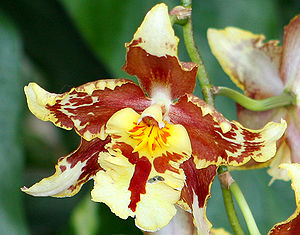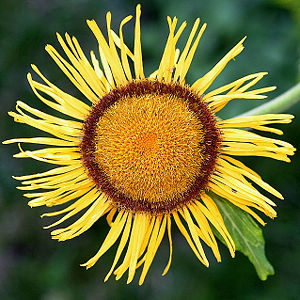Plant Sexuality
Among all living organisms, flowers, which are the reproductive structures of angiosperms, are the most varied physically and show the greatest diversity in methods of reproduction of all biological systems. Carolus Linnaeus (1735 and 1753) proposed a system of classification of flowering plants based on plant structures, since plants employ many different morphological adaptations involving sexual reproduction, flowers played an important role in that classification system. Later on Christian Konrad Sprengel (1793) studied plant sexuality and called it the "revealed secret of nature" and for the first time it was understood that the pollination process involved both biotic and abiotic interactions (Charles Darwin's theories of natural selection utilized this work to promote his idea of evolution).
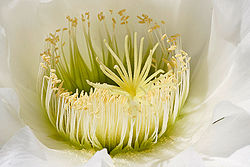
Close-up of an Echinopsis spachiana flower, showing both carpels (only the styles and stigmas are visible) and stamens, making it a complete flower.
Content
» History» Terminology
» Individual reproductive unit (a flower in angiosperms)
» Adaptations
» Individual plant sexuality
» Plant population
» Flower morphology
» Evolution
» Angiosperms
» References
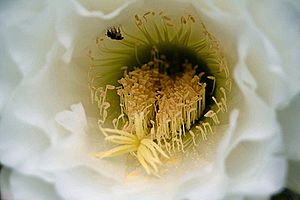
Flower, showing both carpels (only the styles and stigmas are visible) and stamens, making it a complete flower.
History
Unlike animals, plants are immobile and cannot seek out sexual partners for reproduction. The first plants used abiotic means to transport sperm for reproduction, utilizing water and wind. The first plants were aquatic and released sperm freely into the water to be carried by the currents. As plants moved onto land they used a thin film of water or water droplets like liverworts and ferns, in which mobile sperm swam from the male reproduction organs to the female organs. As plants became more complex and developed vascular systems enabling them to grow taller, they used alternation of generations like in ferns or the wind to move spores. In the Paleozoic era progymnosperms reproduced by using spores dispersed on the wind, 350 million years ago the seed plants evolved, including seed ferns, conifers and cordaites all were gymnosperms.Terminology
The flowers of angiosperms are determinate shoots that have sporophylls. The parts of flowers are named by scientists and show great variation in shape, these flower parts include sepals, petals, stamens and carpels. As a group the sepals form the calyx and as a group the petals form the corolla, together the corolla and the calyx is called the perianth. The stamens collectively are called the androecuim and the carpels collectively are called the gynoecium.The complexity of the systems and devices used by plants to achieve sexual reproduction has resulted in botanists and evolutionary biologists using numerous terms to describe physical structures and functional strategies. Dellaporta and Calderon-Urrea (1993) list and define a variety of terms used to describe the modes of sexuality at different levels in flowering plants. This list is reproduced here, generalized to fit more than just plants that have flowers, and expanded to include other terms and more complete definitions.
» Bisexual - or perfect flowers have both male (androecium) and female (gynoecium) reproductive structures, including stamens, carpels, and an ovary. Flowers that contain both androecium and gynoecium are called androgynous or hermaphroditic. Examples of plants with perfect or bisexual flowers include the lily, rose, and most plants with large showy flowers, though a perfect flower does not have to have petals or sepals. Other terms widely used are hermaphrodite, monoclinous, and synoecious. A complete flower is a perfect flower with petals and sepals.
» Unisexual - Reproductive structure that is either functionally male or functionally female. In angiosperms this condition is also called diclinous, imperfect or incomplete.
Adaptations
Flowers of wind pollinated plants tend to lack petals and or sepals. Typically large amounts of pollen are produced and pollination often occurs early in the growing season before leaves can interfere with the dispersal of the pollen. Many trees and all grasses and sedges are wind pollinated, as such they have no need for large fancy flowers. In plants that use insects or other animals to move pollen from one flower to the next, plants have developed greatly modified flower parts to attract pollinators and to facilitate the movement of pollen from one flower to the insect and from the insect back to the next flower. Plants have a number of different means to attract pollinators including color, scent, heat, nectar glands, eatable pollen and flower shape. Along with modifications involving the above structures two other conditions play a very important role in the sexual reproduction of flowering plants, the first is timing of flowering and the other is the size or number of flowers produced.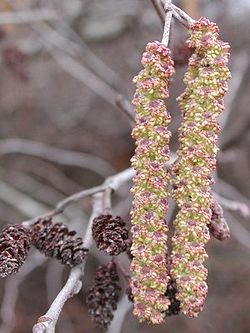
The Alder is monoecious. Shown here: maturing male flower catkins on right, last year's female catkins on left
The largest family of flowering plants is the orchids (Orchidaceae), estimated by some specialists to include up to 35,000 species, which often have highly specialized flowers used to attract insects and facilitate pollination. The stamens are modified to produce pollen in clusters called pollinium, which are attached to insects when crawling into the flower. The flower shapes are modified to force insects to pass by the pollen, which is "glued" to the insect. Some orchids are even more highly specialized, with flower shapes that mimic the shape of insects to attract them to 'mate' with the flowers, a few even have scents that mimic insect pheromones.
Another large group of flowering plants is the Asteraceae or sunflower family with close to 22,000 species, which also have highly modified inflorescences that are flowers collected together in heads composed of a composite of individual flowers called florets. Heads with florets of one sex, when the flowers are pistillate or functionally staminate, or made up of all bisexual florets, are called homogamous and can include discoid and liguliflorous type heads. Some radiate heads may be homogamous too. Plants with heads that have florets of two or more sexual forms are called heterogamous and include radiate and disciform head forms, though some radiate heads may be heterogamous too.
Individual plant sexuality
Many plants have complete flowers that have both male and female parts, others only have male or female parts and still other plants have flowers on the same plant that are a mix of male and female flowers. Some plants even have mixes that include all three types of flowers, where some flowers are only male, some are only female and some are both male and female. A distinction needs to be made between arrangements of sexual parts and the expression of sexuality in single plants verses the species. Some plants also undergo what is called Sex-switching, like Arisaema triphyllum which express sexual differences at different stages of growth. In some arums smaller plants produce all or mostly male flowers and as plants grow larger over the years the male flowers are replaced by more female flowers on the same plant. Arisaema triphyllum thus covers a multitude of sexual conditions in its life time; from nonsexual juvenile plants to young plants that are all male, as plants grow larger they have a mix of both male and female flowers, to large plants that have mostly female flowers. Other species have plants that produce more male flowers early in the year and as plants bloom later in the growing season they produce more female flowers. In plants like Thalictrum dioicum all the plants in the species are ether male or female.» Androecious - plants producing male flowers only, produce pollen but no seeds, the male plants of a Dioecious species.
» Dioecious - refers to a species having separate male and female plants. That is, no individual plant of the species produces both microspores and megaspores; individual plants are either male (producing microspores) or female (producing megaspores). From Greek for "two households". [Individual plants are not called dioecious; they are either gynoecious (female plants) or androecious (male plants).]
» Gynoecious - plants producing female flowers only, produces seeds but no pollen, the female of a Dioecious species. In some plant species or populations all individuals are gynoecious with non sexual reproduction used to produce the next generation.
» Hermaphrodite - A plant that has only bisexual reproductive units (flowers, conifer cones, or functionally equivalent structures). In angiosperm terminology a synonym is monoclinous from the Greek "one bed".
» Monoecious - having separate male and female reproductive units (flowers, conifer cones, or functionally equivalent structures) on the same plant; from Greek for "one household". Individuals bearing separate flowers of both sexes at the same time are called simultaneously or synchronously monoecious. Individuals that bear flowers of one sex at one time are called consecutively monoecious; Plants may first have single sexed flowers and then later have flowers of the other sex. Protoandrous describes individuals that function first as males and then change to females; protogynous describes individuals that function first as females and then change to males.
» Subdioecious, a tendency in some dioecious species to produce monoecious plants. The population produces normally male or female plants but some are hermaphroditic, with female plants producing some male or hermaphroditic flowers or vise versa. The condition is thought to represent a transition between hermaphroditism and dioecy.
» Gynomonoecious - has both hermaphrodite and female structures.
» Andromonoecious - has both hermaphrodite and male structures.
» Subandroecious - plant has mostly male flowers, with a few female or hermaphrodite flowers.
» Subgynoecious - plant has mostly female flowers, with a few male or hermaphrodite flowers.
» Polygamy - Plants with male, female and perfect (hermaphrodite) flowers on the same plant, often called Monicous or sometimes trimonoecious or polygamonoecious plants, (see next section for use for plant populations). A polygamous inflorescence has both unisexual and bisexual flowers.
» Trimonoecious (polygamous) - male, female, and hermaphrodite structures all appear on the same plant.
» Diclinous ("two beds"), an angiosperm term, includes all species with unisexual flowers, although particularly those with only unisexual flowers, i.e. the monoecious and dioecious species.
Plant population
Most often plants show uniform strategies across the species or in populations in their sexual expression and specific terms are used to describe the sexual expression of the species or population.» Hermaphrodite - only hermaphrodite plants with flowers that have both male and female parts.
» Monoecious - only monoecious plants, that is plants have separate male and female flowers on the same plant. A plant species where the male and female organs are found in different flowers on the same plant. These plants are often wind pollinated. Examples of monoecious plants include corn, birch and pine trees, and most fig species.
» Dioecious - only dioecious plants, all plants are either female or male. The American Holly (Ilex opaca) is a famous example.
» Gynodioecious - both female and hermaphrodite plants present. In some plants, strictly female plants are produced by the degeneration of the tapetum, a shell-like structure in the anther of a flower where the pollen cells form,
» Gynoecy - plants are all females in a population, often regulated by environmental factors like temperature, photo period or water availability.
» Androdioecious - both male and hermaphrodite plants present.
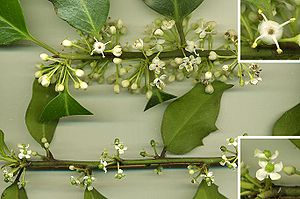
Holly (Ilex aquifolium) is dioecious: (above) shoot with flowers from male plant; (top right) male flower enlarged, showing stamens with pollen and reduced, sterile stigma; (below) shoot with flowers from female plant; (lower right) female flower enlarged, showing stigma and reduced, sterile stamens with no pollen
» Subdioecious - population of unisexual (dioecious) plants, with monoecious individuals too.
» Trioecious - sometimes used in place of subdioecious when male, female, and hermaphrodite plants are more equally mixed within the same population.
» Polygamodioecious, - having bisexual and male flowers on some plants, and bisexual and female flowers on others.
About 11% of all angiosperms are strictly dioecious or monoecious, lntermediate forms of sexual dimorphism, including gynodioecy and androdioecy, represent 7% of the species examined of a survey of 120,000 plant species. In the same survey, 10% of the species contain both unisexual and bisexual flowers.
Dichogamy is common in flowering plants, and occurs when bisexual (perfect) flowers (or sometimes entire plants) produce pollen when the stigmas of the same flower is not receptive of the pollen, this promotes out crossing by limiting what is called autopollination or self pollination or selfing, these plants are called dichogamous. Some plants have bisexual flowers but the pollen is produced before the stigma of the same flower is receptive of pollen, these are described as protandrous flowers; in a similar way, protogyny describes flowers that have stigmas that can accept pollen before the same flower or plant sheds its pollen.
Flower morphology
A species such as the ash tree (Fraxinus excelsior L.), demonstrates the possible range of variation in morphology and functionality exhibited by flowers with respect to gender. Flowers of the ash are wind-pollinated and lack petals and sepals. Structurally, the flowers may be either male or female, or even hermaphroditic, consisting of two anthers and an ovary. A male flower can be morphologically male or hermaphroditic, with anthers and a rudimentary gynoecium. Ash flowers can also be morphologically female, or hermaphroditic and functionally female.Evolution
Angiosperms
It is thought that flowering plants evolved from a common hermaphrodite ancestor, and that dioecy evolved from hermaphroditism. Hermaphroditism is very common in flowering plants; over 85% are hermaphroditic, whereas only about 6-7% are dioecious and 5-6% are monoecious.A fair degree of correlation (though far from complete) exists between dioecy/sub-dioecy and plants that have seeds dispersed by birds (both nuts and berries). It is hypothesized that the concentration of fruit in half of the plants increases dispersal efficiency; female plants can produce a higher density of fruit as they do not expend resources on pollen production, and the dispersal agents (birds) need not waste time looking for fruit on male plants. Other correlations with dioecy include: tropical distribution, woody growth form, perenniality, fleshy fruits, and small, green flowers.
Plant growth regulators can be used to alter flower and plant sexuality, in cucumbers ethephon is used to delay staminate flowering and transforms monoecious lines into all-pistillate or female lines. Gibberellins also increase maleness in cucumbers. Cytokinins have been used in grapes that have undeveloped pistils to produce functional female organs and seed formation.
References
- Barrett, S. C. H. (2002). The evolution of plant sexual diversity. Nature Reviews Genetics 3(4): 274-284.- Costich, D. E. (1995). Gender specialization across a climatic gradient: experimental comparison of monoecious and dioecious Ecballium. Ecology 76 (4): 1036-1050.
- Molnar, S. (2004). Plant Reproductive Systems, internet version posted February 17, 2004.
- Ewing, J. W., & Klein, R. M. (1982). Sex Expression in Jack-in-the-Pulpit. Bulletin of the Torrey Botanical Club 109 (1): 47-50.
- Correlation between male and female reproduction in the subdioecious herb Astilbe biternata (Saxifragaceae) - Olson and Antonovics 87 (6): 837 - American Journal of Botany
- Geber, Monica A. (1999), Gender and sexual dimorphism in flowering plants : with 29 tables, Berlin: Springer, pp. 4.
- Davis, P.H.; Cullen, J. (1979), The identification of flowering plant families, including a key to those native and cultivated in north temperate regions, Cambridge: Cambridge University Press, pp. 106.
- Kiesselbach, T.A. (1999), The structure and reproduction of corn, Cold Spring Harbor, N.Y: Cold Spring Harbor Laboratory Press, pp. 3.
- Waldbauer, Gilbert (2003), What good are bugs? : insects in the web of life, Cambridge, Mass.: Harvard University Press, pp. 33–34.
- Delannay, Xavier (1979), "Evolution of male sterility mechanisms in gynodioecious and dioecious species ofCirsium (Cynareae, Compositae)", Plant Systematics and Evolution 132: 327.
- Males outcompete hermaphrodites for seed siring success in controlled crosses in the polygamous Fraxinus excelsior (Oleaceae) - Morand-Prieur et al. 90 (6): 949 - American Journal of Botany
- Barrett S.C.H.; Case A.L.; Peters G.B. Gender modification and resource allocation in subdioecious Wurmbea dioica (Colchicaceae) Journal of Ecology, Volume 87, Number 1, January 1999 , pp. 123-137(15).
- S. L. Dellaporta, and A. Calderon-Urrea Sex Determination in Flowering Plants Plant Cell 5: Pages 1241-1251.
- Rieger, R., A. Michaelis, and M.M. Green (1991). Glossary of Genetics, Fifth Edition. Springer-Verlag.
- Heilbuth, J.C. (2000). Lower species richness in dioecious clades. American Naturalist 156: 221-241
- Vamosi, J.C., & Vamosi, S.M. (2004). The role of diversification in causing the correlates of dioecy. Evolution 58: 723-731
- Binggeli, P., & Power, J. (1999). Gender variation in ash (Fraxinus excelsior L.)
- Darwin, C. (1877). The Different Forms of Flowers on Plants of the Same Species.
- Dellaporta, S.L. and A. Calderon-Urrea. (1993). Sex determination in flowering plants. The Plant Cell 5: 1241-1251.
- Linnaeus, C. (1735). Systema Naturae.
- Renner, S.S., & Ricklefs, R.E. (1995). Dioecy and its correlates in the flowering plants. American Journal of Botany 82: 596-606.
